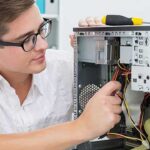Dealing with hardware issues can be frustrating, but understanding how to diagnose and fix them can save you time and money. In this guide, we’ll explore some common hardware problems encountered by computer users and provide step-by-step solutions to resolve them effectively.
Identifying Hardware Issues: Before attempting any repairs, it’s crucial to accurately diagnose the hardware problem. Common signs of hardware issues include strange noises, error messages, system crashes, and hardware components not functioning as expected. Additionally, running diagnostic tests or consulting with a professional technician can help pinpoint the underlying cause of the problem.
Common Hardware Problems and Solutions:
- Faulty Hard Drive:
- Symptoms: Slow performance, frequent crashes, clicking noises.
- Solution: Replace the faulty hard drive with a new one and reinstall the operating system. Data recovery may be necessary if data loss has occurred.
- Defective RAM Modules:
- Symptoms: Random system crashes, blue screen errors, system instability.
- Solution: Test each RAM module individually to identify the faulty one. Replace the defective module with a new one and ensure compatibility with your system.
- Overheating Issues:
- Symptoms: System shutdowns, fan noise, excessive heat emanating from the computer.
- Solution: Clean dust and debris from the cooling vents and fans. Ensure proper airflow by positioning the computer in a well-ventilated area. Consider upgrading the cooling system if overheating persists.
- Failed Power Supply Unit (PSU):
- Symptoms: Failure to power on, random shutdowns, burning smell.
- Solution: Replace the faulty PSU with a new one of equal or greater wattage. Ensure compatibility with your computer’s components and verify proper installation.
- Broken Peripherals (Keyboard, Mouse, etc.):
- Symptoms: Unresponsive keys/buttons, erratic cursor movement, physical damage.
- Solution: Clean the peripherals to remove any debris or dirt. If the issue persists, replace the malfunctioning peripheral with a new one.
Preventative Maintenance Tips:
- Regularly clean dust and debris from your computer’s internal components to prevent overheating.
- Keep your system updated with the latest drivers and firmware to ensure compatibility and stability.
- Backup important data regularly to prevent loss in case of hardware failure.
- Consider investing in surge protectors or uninterruptible power supplies (UPS) to protect your computer from power surges and outages.





